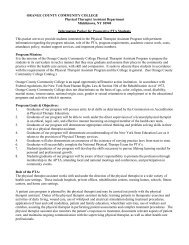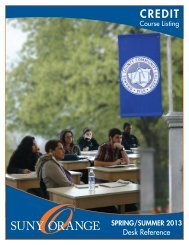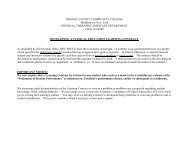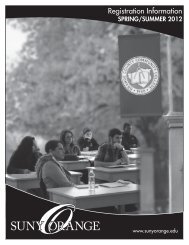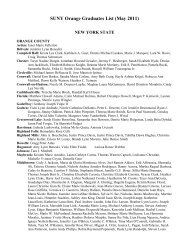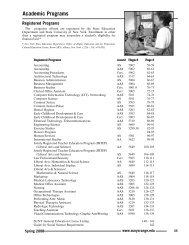Criminal Justiceadministration as they relate to law enforcementagencies. The course will also review and criticallyassess police organizational ethics, corruption, policebrutality, investigation and training.Prerequisite: CRJ 101CRJ 215—Criminal Investigation 13 cr.This course provides an overview and introductionto basic criminal investigations. The course willprovide instruction on proper note taking, reportwriting, interviewing techniques, crime scene searches,suspect identification, crime scene photography,composite sketch drawing, and court preparation.The investigative function and the relationshipbetween investigators and the District Attorney areexplored. Legal issues relative to the investigativefunction such as search and seizure, Mirandawarnings, informant processing, undercoveroperations, wiretapping and surveillance are discussedand evaluated.Prerequisite: completion or concurrent enrollmentCRJ 101CRJ 230—Criminal Justice Internship3 cr.This course provides students with an opportunityto acquire practical “hands-on” experience under thedirect supervision of professionals in a field or areawhich interests them. The internship affordsopportunities for academically related field work in awide range of criminal justice, correctional,government agencies, social service programs, culturalorganizations, businesses, research and non-profitinstitutions.The internship requires 80 hours of supervised fieldwork and 15 hours of class work for a total of 95hours per semester.Prerequisite: Student must be a criminal justicemajor, have completed 30 credits or more, have aCumGPA of 2.5 or higher and have the permission ofthe department chair.CRJ 216—Criminal Investigation 23 cr.The investigation of specific crimes and theexploration of methods utilized in specific criminalinvestigations. The course will explore specific crimessuch as arson, narcotics, sex crimes, child abuse,domestic violence, assaults, burglary, larceny,homicide, auto theft, organized crime, domestic andtransnational terrorist groups and cyberinvestigations. An emphasis on the types of evidencethat are critical to the successful investigation of theabove listed crimes will be thoroughly reviewed andanalyzed. Court room preparation of these specificinvestigations will be thoroughly presented anddiscussed.Prerequisite/Corequisite: CRJ 101CRJ 226—Criminalistics2 lect., 2 lab., 3 cr.This course emphasizes the scientific investigationof crime. The importance of crime scene preservationand laboratory examination of forensic evidence ascritical steps in the investigative process areemphasized. The processing of evidence in the fieldand laboratory are performed during in class lecturesand in laboratory settings. Specific areas that will becovered during this class include crime scene searches,recording and securing forensic evidence, developingand recording latent fingerprints, examination ofbody fluids, microscopic examination of evidencesuch as ballistics, firearms, breathalyzer examinationsand polygraph examinations etc.Prerequisite: CRJ 101, CRJ 215, and CRJ 216182 www.sunyorange.edu <strong>Spring</strong> <strong>2011</strong>
Cyber SecurityCyber Security(Applied Technologies)CFR 221—Computer Forensics2 lect., 2 lab; 3 cr.This course will introduce the student to theaccepted methods of properly conducting a computerforensics investigation, beginning with a discussion ofethics while mapping to the objectives of theInternational Association of Computer InvestigativeSpecialists (IACIS) certification. Students shouldhave a working knowledge of hardware and operatingsystems (OSs) to maximize their success on projectsand exercises throughout the text. Specific topicscovered include: computer forensics andinvestigations as a profession, understandingcomputer investigations, the investigator's office andlaboratory, current computer forensics tools,processing crime and incident scenes, digital evidencecontrols, working with windows and DOS systems,Macintosh and Linux boot processes and diskstructures, data acquisition, domputer forensicanalysis, recovering image files, network forensics, e-mail investigations.Prerequisite: CIT 112, CIT 118CFR 222—Network Forensics2 lect., 2 lab., 3 cr.This course will introduce the student to theaccepted methods of properly conducting a forensicsinvestigation over a network. Students should have aworking knowledge of networks, hardware, andoperating systems (OSs) to maximize their success onprojects and exercises throughout the text. Specifictopics covered include: network forensicsinvestigation overview, the Microsoft networkstructure, processing crime and incident scenes, digitalevidence controls, data acquisition, forensic analysis,recovering image files, the registry structure, registryevidence, presenting the results.Prerequisite: CIT 203, CFR 221Readings and cases are provided to further enable astudent to master the text material while bringingrealistic security issues to the forefront. Readingsfrom current periodicals in the information securitywill also be reviewed.Prerequisite: CIT 116CSS 224—Network Perimeter Security2 lect., 2 lab, 3 cr.This course introduces firewalls and the networksecurity components that can work together toprovide an in-depth defensive perimeter around alocal area network. Accordingly, this course examinesfirewalls in context with the other elements needed foreffective perimeter security as well as security within anetwork. These include packet filtering,authentication, proxy servers, encryption, bastionhosts, virtual private networks, log file maintenance,and intrusion detection systems. Different firewallconfigurations will also be examined.Prerequisite: CIT 203CSS—Cyber Crime Investigations2 lect., 2 lab, 3 cr.This course is designed to provide the student withfoundational knowledge of common techniques usedby most cyber crime investigators. Proceduralapproaches and documentation will be covered.These procedures identify the accepted approaches toprotect a digital crime scene/incident, process thecollected data/information, ensure and document theintegrity of the entire process. The cyber crimeinvestigative procedures will be scrutinized to identifypotential problems. The student will be instructed inhow the procedures and outcomes of thoseprocedures create supporting documentation for alegal case.Prerequisite or concurrent enrollment in CFR 222CSS 223 Information Security3 cr.This course is designed to familiarize the studentwith the foundation utilized by most organizations indeveloping a management framework that willimplement a secure, predictable and dependablesystem throughout the organization. In addition, itwill help students preparing to take the CertifiedInformation Systems Security Professional Exam(CISSP). This is a first course in the introduction andstudy of Information security.A broad view of the field is provided along withenough detail to facilitate an understanding of thetopic as a whole. All pertinent terminology is covered,along with the field’s history and an overview of howto implement and manage an information securityplan.<strong>Spring</strong> <strong>2011</strong>www.sunyorange.edu183
- Page 1 and 2:
Orange CountyCommunity CollegeSprin
- Page 3 and 4:
Message from the PresidentDear Stud
- Page 5 and 6:
About SUNY OrangeThe Middletown Cam
- Page 7:
About SUNY OrangeHudson Valley Educ
- Page 10 and 11:
Admissions Procedures and Requireme
- Page 12 and 13:
Admissions Procedures and Requireme
- Page 14 and 15:
Admissions Procedures and Requireme
- Page 16 and 17:
Educational Partnershipsdevelopment
- Page 18 and 19:
Community PartnershipsThe Departmen
- Page 20 and 21:
Refund PoliciesRefund PoliciesStude
- Page 22 and 23:
Financial AidA variety of financial
- Page 24 and 25:
Financial Aiddependents, or C) a de
- Page 26 and 27:
Financial AidThe student must be en
- Page 28 and 29:
Financial Aidfor 10 to 15 hours wor
- Page 30 and 31:
Financial AidCHOOSING A REPAYMENT P
- Page 32 and 33:
Financial AidWe encourage students
- Page 34 and 35:
Scholarship Opportunities 2010 - 20
- Page 37 and 38:
Academic Policies and ProceduresThe
- Page 39 and 40:
Course Policies and Proceduressched
- Page 41 and 42:
Grades and Grading / Academic Stand
- Page 43 and 44:
• Have a CumGPA lower than 2.0 at
- Page 45 and 46:
class absences and may withdraw stu
- Page 47 and 48:
student is encouraged to contact th
- Page 49 and 50:
Student ServicesStudent Services is
- Page 51 and 52:
Student Servicesexperiences. We wor
- Page 53 and 54:
Student ActivitiesParking TagsParki
- Page 55 and 56:
Learning Assistance ServicesSUNY Or
- Page 57 and 58:
Permitted Credit Courses for Studen
- Page 59 and 60:
Permitted Credit Courses for Studen
- Page 61:
Learning ResourcesThe Writing Consu
- Page 65 and 66:
Degrees / General Degree Requiremen
- Page 67 and 68:
AccountingDegree Awarded: Associate
- Page 69 and 70:
AccountingDegree Awarded: Associate
- Page 71 and 72:
Accounting ProceduresDegree Awarded
- Page 73 and 74:
Architectural TechnologyDegree Awar
- Page 75 and 76:
Business AdministrationDegree Award
- Page 77 and 78:
Business ManagementDegree Awarded:
- Page 79 and 80:
Business StudiesDegree Awarded: Cer
- Page 81 and 82:
Clerical Office AssistantDegree Awa
- Page 83 and 84:
Computer Information Technology-Net
- Page 85 and 86:
Computer Information Technology-Web
- Page 87 and 88:
Computer ScienceDegree Awarded: Ass
- Page 89 and 90:
Criminal JusticeDegree Awarded: Ass
- Page 91 and 92:
Criminal Justice-PoliceDegree Award
- Page 93 and 94:
Cyber SecurityDegree Awarded: Assoc
- Page 95 and 96:
Dental HygieneDegree Awarded: Assoc
- Page 97 and 98:
Early Childhood Development and Car
- Page 99 and 100:
Early Childhood Development and Car
- Page 101 and 102:
Electrical Technology-Telecommunica
- Page 103 and 104:
Emergency ManagementDegree Awarded:
- Page 105 and 106:
Engineering ScienceDegree Awarded:
- Page 107 and 108:
Exercise StudiesDegree Awarded: Ass
- Page 109 and 110:
Honors ProgramDegree Awarded: Assoc
- Page 111 and 112:
Human ServicesDegree Awarded: Assoc
- Page 113 and 114:
International StudiesDegree Awarded
- Page 115 and 116:
Jointly Registered Teacher Educatio
- Page 117 and 118:
Jointly Registered Teacher Educatio
- Page 119 and 120:
Jointly Registered Teacher Educatio
- Page 121 and 122:
Jointly Registered Teacher Educatio
- Page 123 and 124:
Jointly Registered Teacher Educatio
- Page 125 and 126:
Law Enforcement/SecurityDegree Awar
- Page 127 and 128:
Liberal Arts: Humanities and Social
- Page 129 and 130:
Liberal Arts: Individual StudiesDeg
- Page 131 and 132:
Liberal Arts and Sciences: Mathemat
- Page 133 and 134: MarketingDegree Awarded: Associate
- Page 135 and 136: Medical Laboratory TechnologyDegree
- Page 137 and 138: Medical Office AssistantDegree Awar
- Page 139 and 140: NursingDegree Awarded: Associate in
- Page 141 and 142: NursingDegree Awarded: Associate in
- Page 143 and 144: Occupational Therapy AssistantDegre
- Page 145 and 146: Office TechnologiesDegree Awarded:
- Page 147 and 148: Performing Arts: MusicDegree Awarde
- Page 149 and 150: Physical Therapist AssistantDegree
- Page 151 and 152: Radiologic TechnologyDegree Awarded
- Page 153 and 154: Teaching AssistantDegree Awarded: C
- Page 155 and 156: TelecommunicationsDegree Awarded: C
- Page 157 and 158: Visual Communications Technology: G
- Page 159 and 160: SUNY General Education Course Listi
- Page 161: Non-SUNY Elective CategoriesThe fol
- Page 164 and 165: Online LearningSUNY Orange currentl
- Page 166 and 167: Accounting - AnthropologyACC 211—
- Page 168 and 169: Architectural Technology - ArtARC 2
- Page 170 and 171: Artand medium. A museum trip may be
- Page 172 and 173: BiologyBiology(Biology Department)B
- Page 174 and 175: Biology - BusinessBIO 202—Compara
- Page 176 and 177: ChemistryChemistry(Science, Enginee
- Page 178 and 179: CommunicationOrange college radio w
- Page 180 and 181: Computer Information Technology (CI
- Page 182 and 183: Computer ScienceComputer Science(Ap
- Page 186 and 187: Dental HygieneDental Hygiene(Dental
- Page 188 and 189: Economics - EducationEconomics(Psyc
- Page 190 and 191: EducationPrerequisite: EDU 101, EDU
- Page 192 and 193: EngineeringEngineering(Science, Eng
- Page 194 and 195: Englishconstruction of expository e
- Page 196 and 197: English - Field Studies: Travelrela
- Page 198 and 199: Geology - HealthGeology(Science, En
- Page 200 and 201: History - Honorsand ends with the P
- Page 202 and 203: Honors - Human Servicestrends of cu
- Page 204 and 205: Management - MarketingManagement(Bu
- Page 206 and 207: Mathematicsmathematics, and growth
- Page 208 and 209: Medical Laboratory TechnologyMLT 10
- Page 210 and 211: MusicMUS 111—Audio Engineering an
- Page 212 and 213: Music - NursingMUS 226—Elements o
- Page 214 and 215: NursingPrerequisites: ENG 101-2, BI
- Page 216 and 217: Occupational Therapy Assistant - Of
- Page 218 and 219: Philosophy & Religion - Physical Ed
- Page 220 and 221: Physical Education/Exercise Studies
- Page 222 and 223: Physical Therapist AssistantPhysica
- Page 224 and 225: PhysicsPhysics(Science, Engineering
- Page 226 and 227: Psychology - Radiologic TechnologyP
- Page 228 and 229: Radiologic Technology - SociologyRA
- Page 231 and 232: State University of New YorkBoard o
- Page 233 and 234: Administrative StaffCareer and Inte
- Page 235 and 236:
Faculty and Professional StaffEilee
- Page 237 and 238:
Faculty and Professional StaffJames
- Page 239 and 240:
Faculty and Professional StaffKathl
- Page 241 and 242:
Faculty and Professional StaffEric
- Page 243 and 244:
Faculty and Professional StaffLione
- Page 245 and 246:
Adjunct FacultySandra Aber (2008)In
- Page 247 and 248:
Adjunct FacultyJohn Cosco (2005)Ass
- Page 249 and 250:
Adjunct FacultyLinda Gendelman (200
- Page 251 and 252:
Adjunct FacultyEvelyn Kinbar (1997)
- Page 253 and 254:
Adjunct FacultySue Misiak (2002)Ins
- Page 255 and 256:
Adjunct FacultyPeggy Roda (2003)Ins
- Page 257 and 258:
Adjunct FacultyKaren Vespo (2008)In
- Page 259 and 260:
Advisory BoardsAccountingGary Cassi
- Page 261 and 262:
Advisory BoardsBarbara Hansen, RNSt
- Page 263 and 264:
Advisory BoardsBon Secours Communit
- Page 265 and 266:
Academic CalendarSPRNG 2011January
- Page 267 and 268:
Index24 Credit Hour Program .......
- Page 269 and 270:
DirectionsMiddletown, NY CampusNewb




